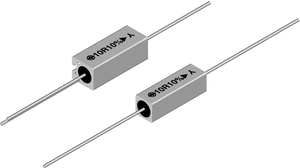Fusible resistor
Fusible resistors are a preferred passive component for many design engineers because they combine two roles: a fuse and a resistor. Using one component versus two saves costs and PCB space. Fusible film resistors are ideal for applications with a lower power level and in which the overload- and surge-handling requirements are not too severe. Power supplies and control circuits commonly used in electric power tools, utility meters, communications equipment, kitchen appliances, and smoke detectors often need a more robust resistor that can withstand higher power, higher short-term pulses, and higher temperatures. These applications require resistors with various levels of surge handling and the conflicting requirement of fusing or failing without collateral damage, and this is where the wirewound type fits the bill.
Fusible film resistor technology typically uses the standard resistor film alloy and materials as a basis for a fusible part. To ensure a reliable and repeatable fusing characteristic, the sputtered film thickness and composition must be more carefully monitored to ensure uniformity across the manufacturing lot. After the filming process, the calibration step is the most critical. It is this process that controls the fusing action of the part, along with dictating the exact resistance value. The more calibration trimming, the shorter the fusing time or the lower the power needed to fuse a given size and resistance value.

